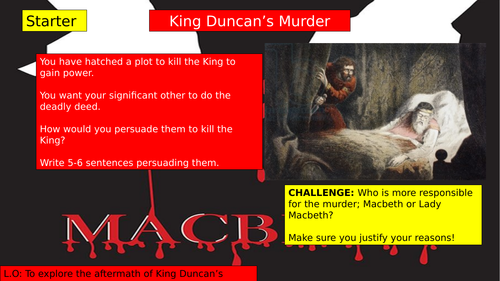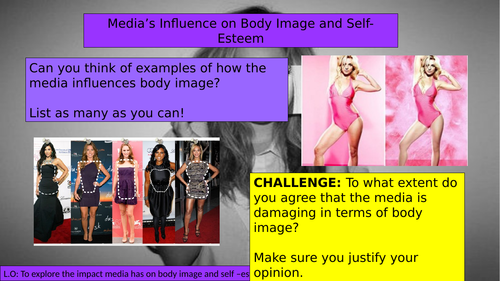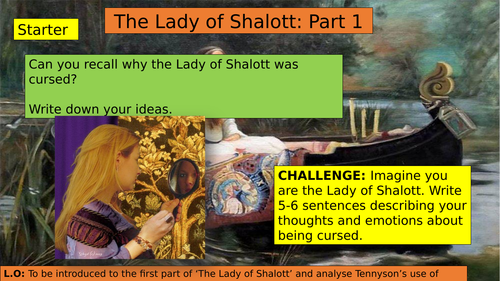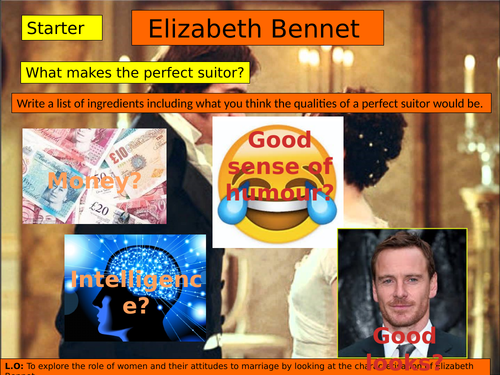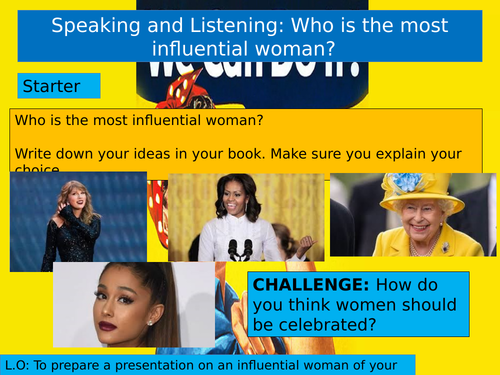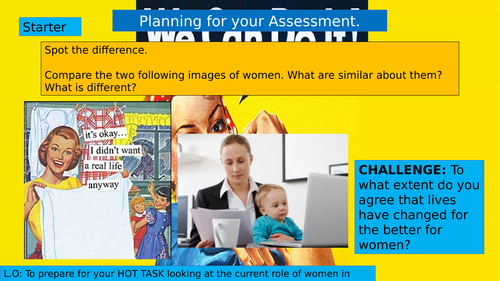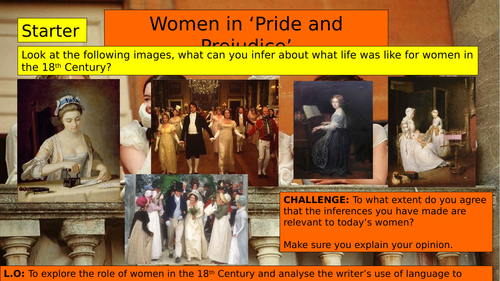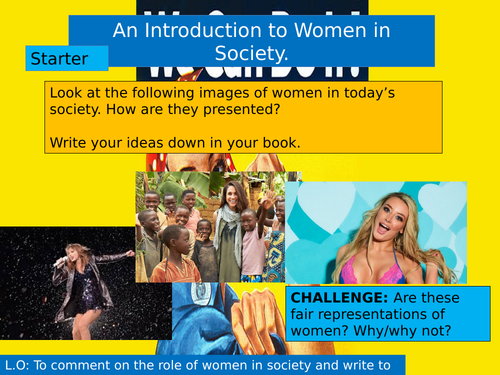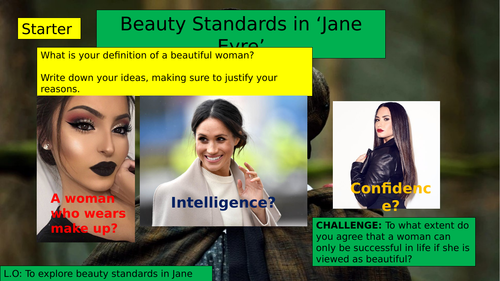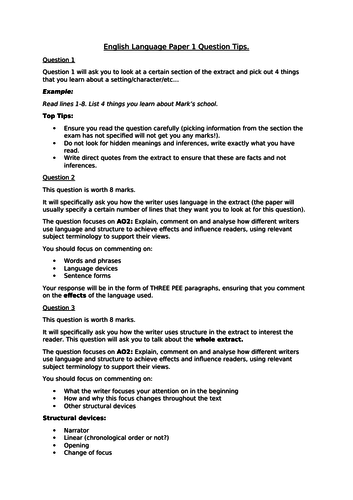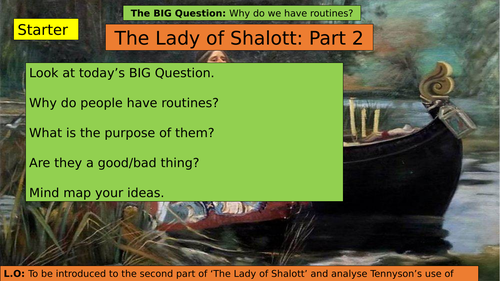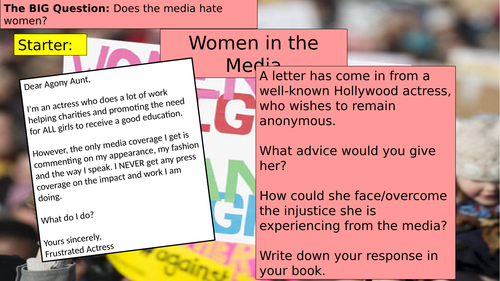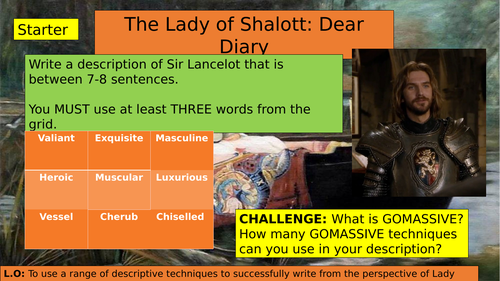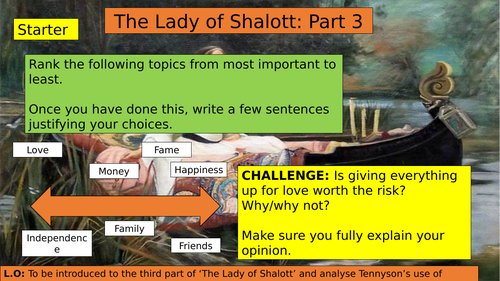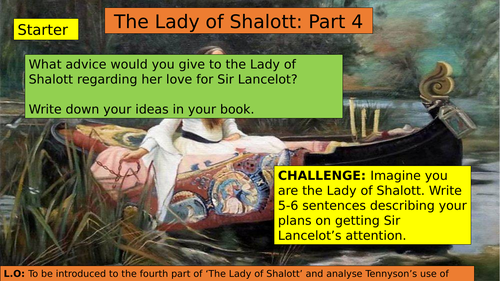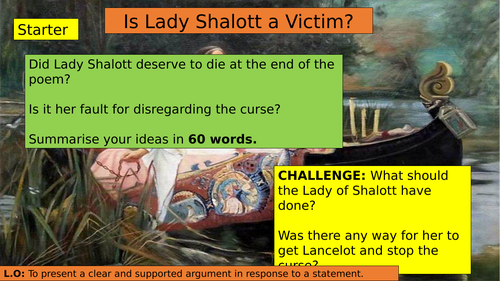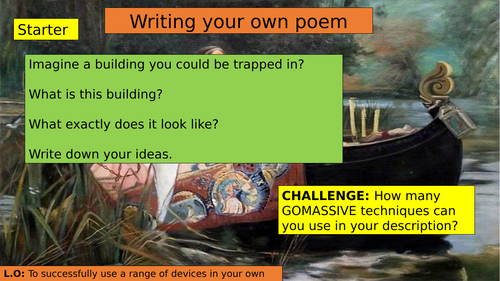60Uploads
18k+Views
4k+Downloads
All resources

Macbeth: Duncan's Murder
This is a middle-ability Year 9 lesson focusing on the murder of King Duncan and Shakespeare’s presentation of Macbeth and Lady Macbeth during this. A short extract from the scene is explored in the lesson (the extract is included). Pupils are required to continue to focus on skills such as identifying and analysing a range of language techniques that Shakespeare has used and consider why he has used them. There is also an activity for pupils to be challenged further to closely analyse a quote to gain a range of interpretations. Lastly, there is the opportunity for creative writing to help them understand the characters further. Sentence starters are also provided to support them with their writing. This lesson is easily adaptable for a KS3 or KS4 class of any ability.

(KS3 7/8/9) Media Influence on Body Image
This is a lesson planned for a middle-ability Year 9 class focusing on how the media influences body image. Pupils will discuss various images and the impact they have on teenagers and their body image. There is also a TED talk (link included in ppt notes) for pupils to watch on the influence of media. Pupils will then write a letter to Seventeen Magazine persuading them to stop body-shaming and focusing on skinny bodies. There are sentence starters included to support pupils in their writing. This lesson is easily adaptable for any KS3 class of any ability.

KS3 (7/8/9) The Lady of Shalott Part One
This is a lesson planned for a high-ability Year 7 class. The lesson focuses on part one of the poem of ‘The Lady of Shalott’ and aims to ensure that pupils understand the language used by Tennyson to introduce the setting and Lady Shalott. There is an activity supporting pupils in picking out key language devices. There is then an activity supporting pupils in writing analytical paragraphs on the first section using the PEACE structure. This lesson is easily adaptable for any KS3 class of any ability.

KS3 (7/8/9) Introduction of the Lady of Shalott
This is a lesson planned for a high-ability Year 7 class. The lesson introduces them to the poem of ‘The Lady of Shalott’ and aims to ensure that pupils understand the plot of the poem and the legend it is based on. A copy of the poem is also attached and the lesson allows pupils to look at Camelot and the Legend of King Arthur. There is also a youtube link attached to a slide so pupils can read along with a spoken performance of the poem. Pupils then have an activity of making their own storyboard, selecting 8 key scenes. This lesson is easily adaptable for any KS3 class of any ability.

(KS3 7/8/9) Elizabeth Bennet
This is a lesson planned for a middle-ability Year 8 class looking at Elizabeth Bennet. Pupils will debate the role of women in the 18th Century before looking at the extract where Elizabeth rejects Darcy. There is support provided to help pupils annotate the extract and sentence starters to write a response about it. This lesson is easily adaptable for any KS3 class of any ability.

Women in Society Speaking and Listening
These are a series of lessons planned for a middle-ability Year 8 class looking at who they think the most influential woman is. Pupils will research an individual of their choice and create a speech (perhaps a powerpoint too) on why their chosen individual deserves to win the award for ‘Greatest modern-day female contributor’. This lesson is easily adaptable for any KS3 class of any ability.

Women in Society Final Assessment
This is a lesson planned for a middle-ability Year 8 class looking at writing a persuasive speech giving a clear argument in response to a statement. Pupils will debate how important equal rights are and there are activities and a worksheet to help them plan their speech. There is then a success criteria and sentence starters to support them in writing their speech. This lesson is easily adaptable for any KS3 class of any ability.

(KS3 7/8/9) Women in 'Pride and Prejudice'
This is a lesson planned for a middle-ability Year 8 class. It explores the role of women in Jane Austen’s time and how women are presented in ‘Pride and Prejudice’. The lesson encourages pupils to analyse key quotes and begin to explore Language Paper 1 Q2 skills with the extract. There is also a model text to support pupils with their analytical writing. This lesson is easily adaptable for any KS3 class of any ability.

(KS3 7/8/9) Women In Society Opening Assessment
This is a lesson planned for a middle-ability Year 8 class. It is an introductory lesson looking at a Women in Society scheme of work. Pupils are encouraged to consider how women are currently presented in today’s society and pupils will write a speech presenting their point of view in response to a statement. This lesson can be easily adapted to any KS3 class of any ability.

(KS3 7/8/9) Beauty Standard in 'Jane Eyre'
This is a lesson planned for a middle-ability Year 8 class looking at beauty in ‘Jane Eyre’. Pupils will debate beauty expectations in the 19th Century before looking at key quotations exploring how Jane is described and the significance of Mr Rochester falling in love with her. There is support provided to help pupils write a paragraph on this through the use of a model text. This lesson is easily adaptable for any KS3 class of any ability.

KS4 English Language Paper 1 TOP TIPS
A worksheet provided top tips to pupils on how to approach English Language Paper 1.

KS3 (7/8/9) The Lady of Shalott Part Two
This is a series of lessons planned for a high-ability Year 7 class. The lessons focus on part two of the poem of ‘The Lady of Shalott’ and aims to ensure that pupils understand the language used by Tennyson to establish setting and the character of Lady Shalott. There are activities including creative writing, supporting pupils in picking out key language devices and how to analyse these in detail. There is then an extended writing activity supporting pupils in writing analytical paragraphs on the second section. This lesson is easily adaptable for any KS3 class of any ability.

KS3 (7/8/9) Speech on Women in the media
This is a lesson planned for a high-ability Year 7 class looking at injustice and how women are treated by the media. Pupils will write a speech arguing that women either are and aren’t fairly presented by the media. There will be activities supporting them in creating arguments and embedding language techniques. The final activity will require students to write their speech and there are sentence starters included to support those who may struggle to start. This lesson is easily adaptable for any KS3 class of any ability.

KS3 (7/8/9) The Lady of Shalott Diary Entry
This is a lesson planned for a high-ability Year 7 class. The lesson focuses on Lady Shalott’s first glance of Sir Lancelot in the poem ‘The Lady of Shalott’ and aims to ensure that pupils understand how to embed a range of GOMASSIVE techniques into their creative writing. There are activities supporting pupils in improving their vocabulary and planning GOMASSIVE techniques to use. There is then an activity supporting pupils in writing their diary entry using a model text. This lesson is easily adaptable for any KS3 class of any ability.

KS3 (7/8/9) The Lady of Shalott Part Three
This is a lesson planned for a high-ability Year 7 class. The lesson focuses on part three of the poem of ‘The Lady of Shalott’ and aims to ensure that pupils understand the language used by Tennyson to introduce Sir Lancelot. There is an activity supporting pupils in picking out key language devices. There is then an activity supporting pupils in writing analytical paragraphs on the first section using the PEACE structure and a model paragraph. This lesson is easily adaptable for any KS3 class of any ability.

KS3 (7/8/9) The Lady of Shalott Part Four
This is a lesson planned for a high-ability Year 7 class. The lesson focuses on part four of the poem of ‘The Lady of Shalott’ and aims to ensure that pupils understand the language used by Tennyson to create atmosphere. There is an activity supporting pupils in picking out key language devices. There is then an activity supporting pupils in writing analytical paragraphs on the first section using the PEACE structure and a model paragraph. This lesson is easily adaptable for any KS3 class of any ability.

KS3 (7/8/9) The Lady of Shalott: To what extent do you agree?
This is a lesson planned for a high-ability Year 7 class. The lesson focuses on the poem of ‘The Lady of Shalott’ and aims to ensure that pupils can explore both sides of the argument as to whether the Lady Shalott is a victim in the poem. There is an activity supporting pupils in picking out key language devices and turning these into agree and disagree points, with examples. There is then an activity supporting pupils in writing analytical paragraphs with a model paragraph to help. This lesson is easily adaptable for any KS3 class of any ability.

KS3 (7/8/9) The Lady of Shalott Final Assessment
These are two lessons planned for a high-ability Year 7 class. The lessons focus on the whole ‘The Lady of Shalott’ poem and aims to ensure that pupils understand the language used by Tennyson to present the character of Lady Shalott. There is an activity supporting pupils in picking out key language devices and quotes. There is also support with sentence starters and a guide on how to use the PEACE structure for their paragraphs. This lesson is easily adaptable for any KS3 class of any ability.

KS3 (7/8/9) Writing a poem inspired by 'The Lady of Shalott'
This is a lesson planned for a high-ability Year 7 class. The lesson focuses on students writing their own poem, based on their studies of the poem of ‘The Lady of Shalott’ and aims to ensure that pupils understand the language techniques and structure that can be used in a poem. There is an activity supporting pupils in planning key language device, with a planning sheet included. This lesson is easily adaptable for any KS3 class of any ability.

Injustice themed bundle of lessons
This bundle consists of seven lessons focusing on the theme of ‘Injustice’, These English lessons were planned for a high-ability KS3 class, focusing on building key skills in relation to the English Language Paper 2 exam. The lessons focus on the #MeToo movement (involving an assessment to test pupils’ initial skills), two lessons focusing on the impact of Malala and writers’ differing attitudes to this and attitudes towards women in the media, as well as Martin Luther King’s famous speech. These lessons explore both analytical and creative writing skills and are easily adaptable for all KS3 class of all abilities.

